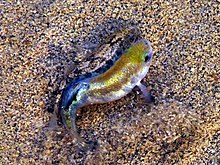Cyprinodon salinus
| Death Valley Pupfish | |
|---|---|
 |
|
| Male (right) and female (left) | |
| Scientific classification | |
| Kingdom: | Animalia |
| Phylum: | Chordata |
| Class: | Actinopterygii |
| Order: | Cyprinodontiformes |
| Family: | Cyprinodontidae |
| Genus: | Cyprinodon |
| Species: | C. salinus |
| Binomial name | |
|
Cyprinodon salinus R. R. Miller, 1943 |
|
| Subspecies | |
|
|
The Death Valley pupfish (Cyprinodon salinus), also known as Salt Creek pupfish, is found in Death Valley National Park. There are two recognized subspecies: C. s. salinus and C. s. milleri. It is endemic to two small, isolated locations and currently classified as endangered.
The desert pupfish is a small, silvery colored fish with 6-9 dark bands on its sides. It has an average length of 3.7 centimetres (1.5 in), with a recorded maximum of 7.8 centimetres (3.1 in).
The males turn bright blue during mating season, April through October. The pupfish can withstand harsh conditions that would kill other fish: water that is 4 times more saline than the ocean, hot water up to 116 °F (47 °C), and cold water down to 32 °F (0 °C).
This species is known from only two locations in Death Valley: Salt Creek (subspecies salinus) at about 49 meters below sea level, and Cottonball Marsh (subspecies milleri), at about 80 meters below sea level. They are thought to be the remainders of a large ecosystem of fish species that lived in Lake Manly, which dried up at the end of the last ice age leaving the present day Death Valley.
The Salt Creek subspecies is also found at River Springs and Soda Lake, in Death Valley National Park.
The desert pupfish has been classified as endangered by the IUCN due to its extremely restricted distribution (if the two extant locations were treated as a single unit, it would be considered critically endangered). Numbers of individuals at the locations are highly seasonally variable, and fluctuate with water level and flow volume. While the entire range of the species is located in a protected area, it may be under threat from accidental introduction of non-native species, local catastrophic events, and excessive pumping of the aquifer that feeds the habitat.
...
Wikipedia

